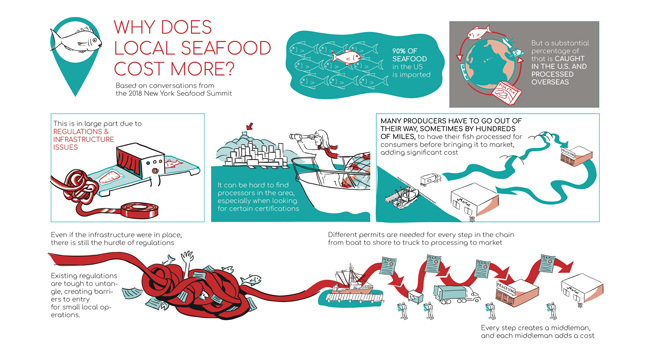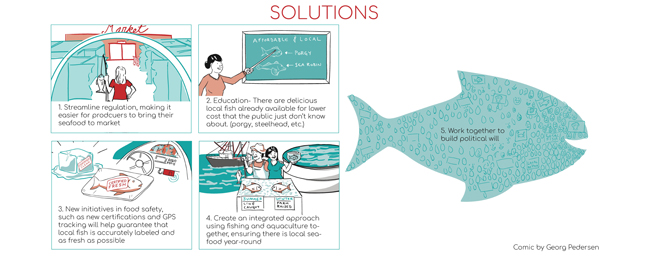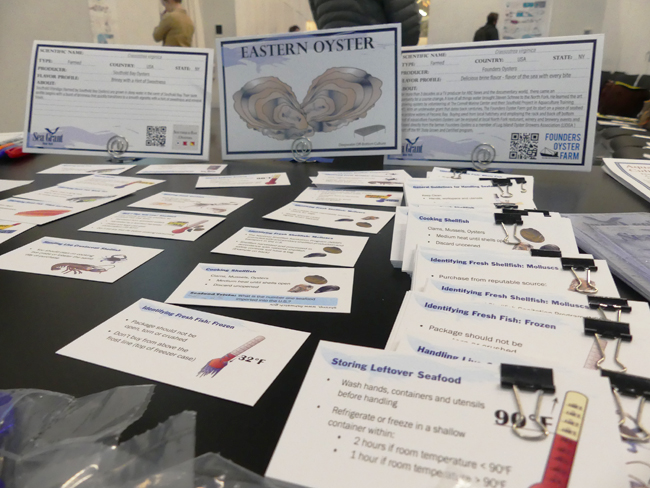Contacts:
Michael Ciaramella, NYSG’s Seafood Specialist, E: Mc2544@cornell.edu, P: (631) 632-8730
New York, NY, November 12, 2019 - Each year at the New York Seafood Summit, New York Sea Grant (NYSG) and its partners highlight some of the State's bountiful seafood supply and introduce participants to the delicious, diverse, and versatile seafood’s available locally.
On February 3, 2020, Project Farmhouse (76 East 13th Street / New York, NY 10003) will be the site of a fourth summit. Additional information about the event, including registration (for which registration closes January 18th), is at www.nyseagrant.org/seafoodsummit.
Late this past February, NYSG, in collaboration with the Center for Aquatic Animal Research & Management, Green Rabbits Projects and GrowNYC, hosted the third summit in this series for seafood professionals in a variety of disciplines, as well as the interested public.
As with the upcoming summit, GrowNYC hosted this past year's event at their Project Farmhouse facility near Union Square. Grow NYC is an organization dedicated to improving New York City’s quality of life through environmental programs designed to create a clean and healthy environment for future generations.
Informal presentations were volunteered by attendees, ranging from blockchain applications for the seafood industry, to aquaponic farms in Brooklyn. Short question-and-answer sessions allowed attendees to connect over professional experiences and industry challenges.
Semi-structured conversations were then held in the second half of the summit. Progress to date from the 2018 Seafood Summit was discussed. The summit offered a forum for professionals frequently navigating the federal, state, local, as well as voluntary regulations from third party certifiers. Regulation compliance is among the most difficult aspect of the seafood business, and those difficulties were discussed in detail, as well as potential possible remediations.

Credit: Georg Pedersen, Green Rabbits Projects & Drawn Stories

The graphic "Why Does Local Seafood Cost More?," pictured above and below, illustrates some of the cost-inducing aspects of regulation and was unveiled at the summit, with an opportunity for attendees to comment. Though over 90% of seafood consumed in the U.S. is imported, a substantial percentage of that is caught in United States waters and processed overseas.

Why is this? A web of decentralized regulations permit requirements every step of the way from sea to plate that can make it difficult and in some instances impossible to compete with overseas seafood processors. American processing infrastructure is diminishing, which contributes to American seafood being moved overseas. Understanding regulatory challenges and working to streamline regulation, educating consumers on the value of buying local seafood, new initiatives in seafood safety, and creating an integrated approach with wild-caught and aquaculture can help address import-export problems and increase consumption of New York seafood.
Discussions of the challenges and trends of the seafood industry covered at the 2019 Seafood Summit will be used to guide NYSG’s Seafood outreach efforts, as well as shape conversations at the 2020 Seafood Summit. Ultimately, the summit serves NYSG by illustrating what challenges face the New York seafood economy, and how outreach efforts can be tailored to mitigate or eliminate those challenges.

In spring 2018, NYSG Seafood Specialist Michael Ciaramella unveiled a series of seafood information cards designed to educate consumers on selecting, handling and preparing seafood appropriately and safely. The card series encompasses seafood consumption from dock to dish and is designed to be distributed anywhere fish are sold in New York. Credit: Ryan Strother/NYSG.
Observations made by seafood professionals are utilized by Michael Ciaramella, NYSG’s Seafood Specialist, to tailor resources, programming, and outreach efforts to assist producers and consumers in New York’s food industry.
A primary benefit of the annual Seafood Summit is to inspire ongoing conversations between various actors and stakeholders in the seafood industry. One hundred percent of summit participants who responded to a post-summit survey planned, in some capacity, to continue conversations started at the 2019 summit.
Participants of the summit indicated tasks they hoped to work towards before the 2020 Seafood Summit. Those tasks include increasing transparency in the seafood supply chain, creating more educational materials for end-users, and promoting buyers who support local seafood, among many others. Summit organizers challenged attendees to work towards meeting these goals and will assess progress in 2020.
More Info: New York Sea Grant
New York Sea Grant (NYSG), a cooperative program of Cornell University
and the State University of New York (SUNY), is one of 33 university-based
programs under the National Oceanic and Atmospheric Administration’s
National Sea Grant College Program.
Since 1971, NYSG has represented a statewide network of integrated
research, education and extension services promoting coastal community
economic vitality, environmental sustainability and citizen awareness
and understanding about the State’s marine and Great Lakes resources.
Through NYSG’s efforts, the combined talents of university scientists
and extension specialists help develop and transfer science-based
information to many coastal user groups—businesses and industries,
federal, state and local government decision-makers and agency managers,
educators, the media and the interested public.
The program maintains Great Lakes offices at Cornell University, SUNY
Buffalo, SUNY Oswego and the Wayne County Cooperative Extension office
in Newark. In the State's marine waters, NYSG has offices at Stony Brook
University in Long Island, Brooklyn College and Cornell Cooperative
Extension in NYC and Kingston in the Hudson Valley.
For updates on Sea Grant activities: www.nyseagrant.org has RSS, Facebook, Twitter, and YouTube links. NYSG offers a free e-list sign up via www.nyseagrant.org/nycoastlines for its flagship publication, NY Coastlines/Currents, which is published quarterly. Our program also produces an occasional e-newsletter,"NOAA Sea Grant's Social Media Review," via its blog, www.nyseagrant.org/blog.